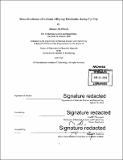| dc.contributor.advisor | Carl V. Thompson. | en_US |
| dc.contributor.author | Al-Obeidi, Ahmed (Ahmed F.) | en_US |
| dc.contributor.other | Massachusetts Institute of Technology. Department of Materials Science and Engineering. | en_US |
| dc.date.accessioned | 2016-09-13T19:09:21Z | |
| dc.date.available | 2016-09-13T19:09:21Z | |
| dc.date.issued | 2016 | en_US |
| dc.identifier.uri | http://hdl.handle.net/1721.1/104180 | |
| dc.description | Thesis: Ph. D. in Electronic Materials, Massachusetts Institute of Technology, Department of Materials Science and Engineering, 2016. | en_US |
| dc.description | Cataloged from PDF version of thesis. "June 2016." | en_US |
| dc.description | Includes bibliographical references (pages 163-189). | en_US |
| dc.description.abstract | Germanium and silicon are ideal candidate materials for use as anodes in microbatteries since both are well established in microelectronics and reversibly store large amounts of lithium. However, implementation of either material has been limited by poor cyclability due to the large volumetric changes occurring during cycling. To better understand the mechanical stresses associated with these changes, in situ stress curvature measurements on thin film electrodes were conducted. The effect of the initial electrode structure on electrochemistry and mechanics was investigated by post-deposition annealing of hydrogenated silicon thin films. Compared to as-deposited films, annealed electrodes lithiated at lower potentials during the first cycle and could form Li₁₅Si₄ . Moreover, annealed electrodes underwent large structural changes in the first two cycles compared to as-deposited films, with polycrystalline silicon films showing the largest change. The changes in electrochemistry and mechanical behavior were attributed to the loss of hydrogen and densification of the film. In addition to silicon, stress evolution in lithium-germanium films was also investigated and stresses were found to be roughly one-third those of silicon. Rate testing revealed that germanium electrodes exhibit a smaller loss in capacity at high cycling rates than silicon. Cycling below 100mV resulted in crystalline Li₁₅Ge₄ formation which appeared as a tensile peak in the stress-capacity plots. Extended cycling of uncoated electrodes resulted in an irreversible reduction of stress but no loss in capacity, an outcome associated with the thin film fracturing while remaining adherent to the substrate. The reduced plastic flow stresses observed in lithium-germanium and their weak dependence on cycling rate may explain why germanium offers improved cyclability and reduced rate sensitivity compared to silicon. In addition to uncoated electrodes, lithium phosphorous oxynitride (LiPON) coated electrodes were also examined. By coating silicon and germanium thin films with LiPON, mechanical degradation (i.e. crack and island formation) and chemical degradation (i.e. reduction in solid electrolyte interphase formation) processes were strongly suppressed. The improvement in mechanical and electrochemical stability enabled more detailed studies of lithium-silicon and lithium-germanium alloying, including the kinetics of phase formation and dissolution (e.g. of Li₁₅Si₄ and Li₁₅Ge₄). | en_US |
| dc.description.statementofresponsibility | by Ahmed Al-Obeidi. | en_US |
| dc.format.extent | 189 pages | en_US |
| dc.language.iso | eng | en_US |
| dc.publisher | Massachusetts Institute of Technology | en_US |
| dc.rights | M.I.T. theses are protected by copyright. They may be viewed from this source for any purpose, but reproduction or distribution in any format is prohibited without written permission. See provided URL for inquiries about permission. | en_US |
| dc.rights.uri | http://dspace.mit.edu/handle/1721.1/7582 | en_US |
| dc.subject | Materials Science and Engineering. | en_US |
| dc.title | Stress evolution of lithium alloying electrodes during cycling | en_US |
| dc.type | Thesis | en_US |
| dc.description.degree | Ph. D. in Electronic Materials | en_US |
| dc.contributor.department | Massachusetts Institute of Technology. Department of Materials Science and Engineering | |
| dc.identifier.oclc | 958134237 | en_US |
